#comics history
Text
In Plagiarism and You(Tube), Hbomb says "If you consider something so obscure you can get away with stealing it, you do not respect it." Save that line for the next time someone tries to tell you that Roy Lichtenstein brought respect to comics as art.
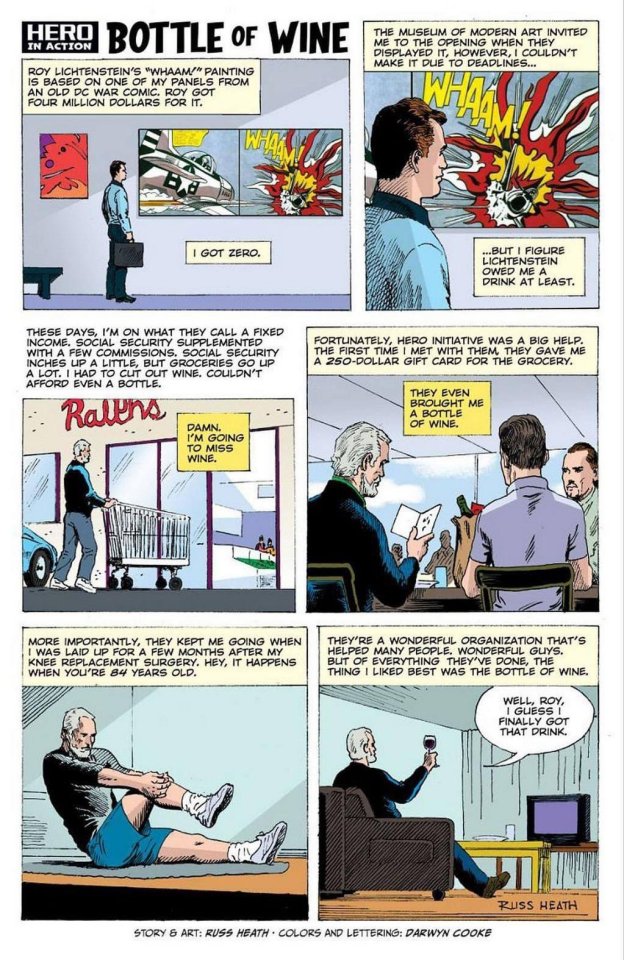
It's since been pointed out that while Lichtenstein did copy one of Russ Heath's drawings of an airplane getting hit, the painting depicted above was actually copied off Irv Norvick, because Lichtenstein did this so many times to so many comic artists.

In Lichtenstein's defense, he was doing this in a time when comic artists frequently weren't even credited in the issues themselves. In his condemnation, he never even tried to check, nor has he made any move to pay or credit any of the comic artists who recognized their own work later on. Rather than elevating the "low art" of comics, he was widening the gap of financial success and respect even further.
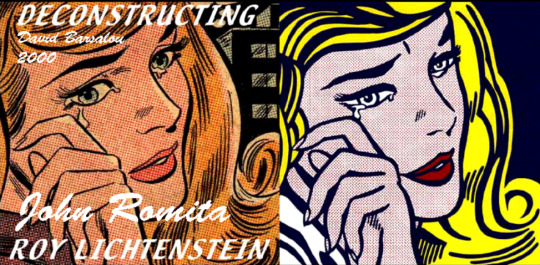
The Hbomberguy of this story is art historian David Barsalou, who has now spent decades tracking down the original art and the names of the original artists used in Lichtenstein's most famous output. Here's the flickr gallery for the Deconstructing Roy Lichtenstein project. Frequently copied were Tony Abruzzo, Ted Galindo, Mike Sekowsky, Joe Kubert, Jerry Grandenetti, and dozens more Golden Age artists who aren't very well known in comics circles, let alone art history books. Many of them died in poverty. That's something that the Hero Initiative, mentioned in Russ Heath's comic above, aims to prevent.
Also, Lichtenstein didn't even paint Ben-Day dots. That's a specific thing.
#roy lichtenstein#plagiarism#olivertxt#once you've seen them side by side. the original art is virtually ALWAYS more technically solid#art being ''bad'' doesn't make it not art but just the insult of making thousands of times more copying your work *worse*#lichtenstein did a lot of original (or harder to attribute) work later on but the peak of his fame was majority this stuff#comics history
13K notes
·
View notes
Text
Misunderstanding
I received a note from someone who was upset I “failed to cite Scott McCloud’s Understanding Comics” in my research for my work on Neil Gaiman's Chivalry and the essays I wrote about it.
I really appreciate that people want to make sure credit goes where it's due, and I have a lot of respect for Scott McCloud's accomplishment with his wonderful book.
I haven't read it myself in some years, and didn't cite it in my articles because I didn't reference it. I don't even know where my copy is so I don't know what McCloud referenced, either.
The information in my articles re: illuminated manuscripts and the Bayeux Tapestry, as well as other theories about the development of sequential art from prehistory, not only predate McCloud's work (and in fact, predate McCloud's birth,) but they are so common and so well known in comics circles that asking me to cite them seems as weird to me as asking me to cite the information that George Washington was the first President of the United States.
A part of me wonders if someone is trying to play, "Let's you and him fight."
No.
But I’m happy to bring to your attention some reading material.
Stephen Becker in his 1959 work Comic Art in America: A Social History of the Funnies, the Political Cartoons, Magazine Humor, Sporting Cartoons, and Animated Cartoons was among the first to discuss the Bayeux Tapestry as comic art. I read that book sometime in the 1980’s. I think a lot of people assume the Bayeux tapestry as comic art was McCloud’s idea, but we don’t all walk around with a reference library in our heads, so there you go. I can’t find my copy of Becker’s work to quote, but I did find an article by Arthur Asa Berger with a mention of the Bayeux Tapestry as comic art in the summer 1978 issue of The Wilson Quarterly.

My first exposure to the idea of comics as descendant of fine art was Maurice Horn’s 1976 The World Encyclopedia of Comics which was my first read re: comics history. I still have my tattered 1976 edition.
While Horn scorned the idea that tapestries and manuscripts could be comic art (see, it was a matter of discussion way back then, so much so that authors were writing snarky asides to one another about it,) he believed the origin of sequential art was in the Renaissance sketches of Leonardo da Vinci - which I think everyone now agrees is kind of a bonkers idea.

I think Horn was just intent on elevating the comic art form by hooking up with da Vinci.
You go, boi.
Comics as descendant of art on scrolls is a very common theory, the easiest to trace being in Manga! Manga! The World of Japanese Comics by Fred Schodt published in 1983 when I was still a teenager. I can't find my copy to show examples, but this text is still in print and you can go read it for yourself.
I was introduced to manga by cartoonist Leslie Sternbergh and bought Schodt’s book at Books Kinokuniya on (I think) a trip to New York around the time of first publication of Schodt’s work. And years later took a trip to Japan with Fred Schodt and a group of cartoonists including Jeff Smith and Jules Fieffer, Nicole Hollander, and Denys Cowan as the guests of Tezuka Productions.
Here we all are.

So, I’m familiar with manga, see.
As for comics as descendant of cave paintings, hieroglyphics and ancient art in general, Will Eisner’s 1985 Comics and Sequential Art not only made all of those points, but made those points with comic art examples. Like these.

And this.

And this.
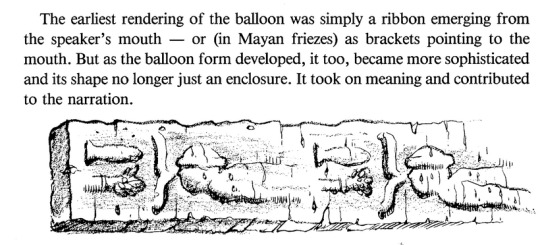
And more than a few words on this:


I find it amusing that someone is questioning why I didn’t cite McCloud when what you should probably be questioning is why more people don’t cite Eisner who produced his book eight years before McCloud published his and who is well known to have influenced McCloud.
Whatever. My book's autographed.
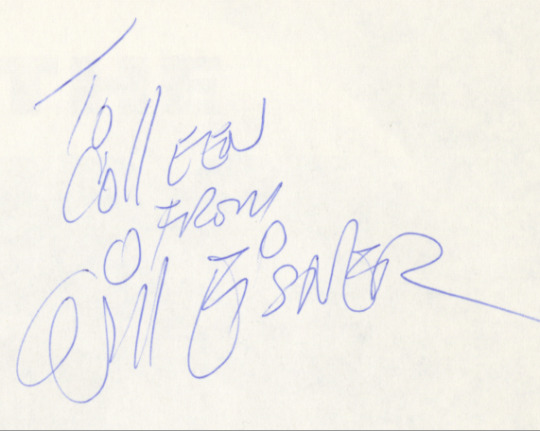
I also danced with Eisner. Eat your heart out.
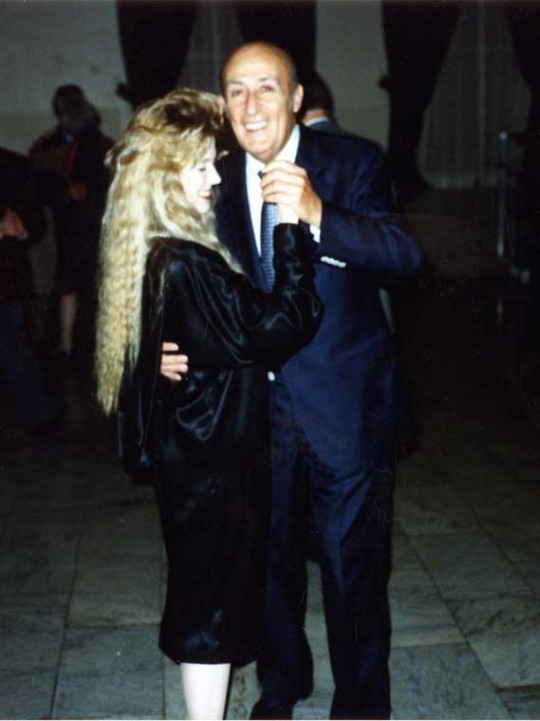
Understanding Comics is a terrific work with huge advantages over every book (that I know of) about comics that came before: it taught comics entirely in the language of comics.
But the discussion in it about the origins of comics and my work especially re: illuminated manuscripts/tapestries, did not originate with McCloud. I research illuminated manuscripts because it’s my hobby and it informs my art.
I encourage everyone to read Understanding Comics because it is an outstanding work.
But it’s not the book that introduced me to the concepts of the development of comic art. It’s not even the point of origin of those concepts. So, there is no reason to cite it.
Also, shocking as it may seem, I occasionally come up with ideas on my own. While I'm younger than McCloud, I've actually been a comics pro longer than he has. So I've had plenty of opportunity to, you know, read things and toss things around, and decide for myself.
When I first read Chivalry and first begged Neil Gaiman to let me adapt it, my head full of the work of Alberto Sangorski and his art for Tennyson’s Le Morte D’Arthur, Understanding Comics hadn’t been published yet.
It's been a good twelve years since I last read McCloud's work, and I don't think I've spoken to him five times in the last three decades. But I'm pretty sure he never mentioned Sangorski.
I hope that clears everything up, and maybe introduces some of you to some works you might not be aware of.
Have a great day.
#understanding comics#comics history#neil gaiman#scott mccloud#chivalry#jules fieffer#tezuka productions#manga#will eisner
2K notes
·
View notes
Text
It's almost time for Tʜᴇ Kɪʟʟɪɴɢ Vᴏᴛᴇ.
September 15th marks the 35th anniversary of the poll to kill Batman's sidekick, Robin.

Thirty-five years ago, on September 9th 1988, Batman #427 "A Death in the Family - Chapters III & IV" went on sale. This issue announced a vote-by-phone poll to allow fans to determine whether Robin would live or die in the next issue, Batman #428. There were two premium-rate phone numbers—a call to 1-900-720-2660 was a vote for Robin's survival, and a call to 1-900-720-2666 was a vote for Robin's death. Each call cost $0.50 (approximately $1.30 in 2023 dollars, after adjusting for inflation since 1988), and a caller could call multiple times. The poll was only open to paying callers in the U.S. and Canada for a window of 35 hours, starting on 15 September 1988 at 9AM EST.
Tʜᴇ Kɪʟʟɪɴɢ Vᴏᴛᴇ marks the 35th anniversary of the 35-hour poll to kill Robin. The aim of this mini-project is to discuss the phone poll to decide Robin's fate—the who and the how and the why. This blog will create and share media that may cover: the history of Robin; audiences' attitudes toward Robin; the creative and corporate forces' attitudes toward Robin; the rise of the Dark Age of Comics; comparing and contrasting the various Robins; etc.
From September 15th at 9 AM EST to September 16th at 9 AM EST, Tʜᴇ Kɪʟʟɪɴɢ Vᴏᴛᴇ will host a 24-hour poll asking voters whether Robin should live or die, as a rough reenactment of the original 1988 poll. Starting now, submissions of anonymous propaganda making the case for Robin's survival and/or death are welcome—arguments from both sides will be included with the poll as a "voter guide".
Asks and submissions are welcome. If you'd like to recommend a post to be reblogged to this blog, then please tag original posts with #thekillingvote, or ping any post with @thekillingvote. Stay tuned for the possible opening of an Archive Of Our Own collection.
The time of this announcement is 09/09 at 9 AM EST. Just like in 1988, we have less than a week's notice until the big day.

@dc-fandom-events @dc-event-calendar @dcfandomevents @dailyjasontodd @40-years-of-robin-ii
#DC Robin#Robin DC#DC Comics#Jason Todd#thekillingvote#Batman comics#comics#Batman#Batman A Death in the Family#Batfamily#Batfam#Bat family#Batkids#Batbros#Batsibs#Jim Starlin#Batsiblings#Jason Todd meta#comics history#Jim Aparo#Dennis O'Neil#ADitF#1988#described#ID in alt#image ID#ID in alt text#GIF#child death mention CW#child murder CW
335 notes
·
View notes
Text
It’s the Girl in the Red Truck, Charlie Brown (Video, 1988)
“I wanted this to be my ‘Citizen Kane,’ but it’s not.” - Charles M. Schulz. You can watch it here.
Here's an article, a podcast episode, and a 1988 review from the New York Times.

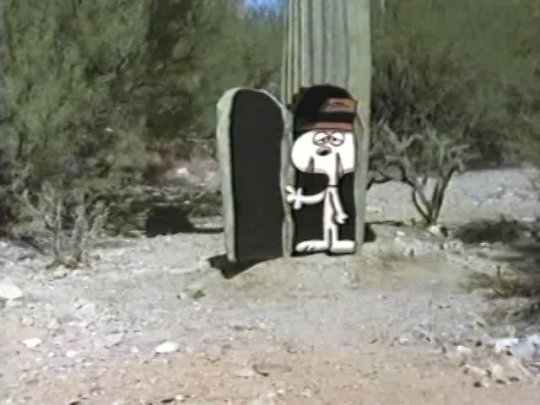



#internet archive#video#videos#cartoon#cartoons#animation#animation history#peanuts#comic#comics#comics history#comic strip#comic strips#newspaper comics#obscure cartoons#obscure animation#tv special#1988#1980s#80s
104 notes
·
View notes
Note
So I saw your post here [https://www.tumblr.com/inamindfarfaraway/690058488775327745/batfamily-fanworks-that-purport-to-be-set-in-the] and oh my gosh YOU ARE SO RIGHT!
As much as I enjoy it, Hush is definitely to blame for this as it is held as THE end-all-be-all of all BatFam stories yet Cass (who an acclaimed ongoing series as Batgirl around the same time) was suspiciously missing from it along with Steph.
Yet we only ever get flashbacks to Bab's time as Batgirl so that storyline also ended up cementing Bab's legacy as "the one and only Batgirl".
Methinks a certain editor in charge at the time mandated for Cass and Steph to not appear in Hush because they-according to him-"were way too toxic" for said storyline.
Because you see, as soon as he became a leading editor, his number one priority was getting rid of Steph and stripping Cass of her Batgirl role.
And so the age of darkness began...
First, there was War Games that solely existed to torture Steph in the most vile, most voyeuristic ways before killing her off.
Then there was Robin: One Year Later, one of the worst, horrific character-assassination storylines since Spider-Man's One More Day, where Cass was suddenly turned into an over-the-top Saturday Morning cartoon villain obsessed with killing everyone, giving long-winded "together we can rule the world" speeches and being able to speak and write in fluent Navajo. ONE OF THE MOST DIFFICULT LANGUAGES IN THE WORLD.
Then there was Redemption Road which, despite its good moments and happy ending, did even more damage to Cass's character.
And finally, we have Battle For The Cowl which ended up pushing Cass and Steph so far into the background, they were basically erased from the BatFamily altogether.
Yet despite Steph's well-received run as Batgirl, DC's poor marketing and the lead up to the New 52 prevented the series from becoming a proper bestseller and it was cancelled without any fanfare whatsoever.
Still, all those horrible decisions and storylines (like War Games and Robin: One Year Later) did such massive, long term damage to the characters that, even despite all the small good things (Steph's Batgirl series to the excellent Gates Of Gotham mini-series starring Cass), they were buried from public consciousness.
As for Duke (another character, I'm a fan of), I think its just a case of him being a very recent character, a lack of marketing and higher-ups not knowing what to do with him.
As for the asshole editor who everything to burry the Batgirls, he was eventually fired for creating an "unsafe working environment".
And yes, his name rhymes with "Ban Video".
As for the people who keep erasing Cass, Steph and Duke from fan works, I know it sounds depressing but hear me out:
Fandom, be it comics, video games, films, cartoons, TV shows, ect, has an unconscious bias of white male favouritism.
(Yes, I know Dick is Romani, Damien half-Arabic/Asian yet they're still quite white-passing)
YES! THANK YOU! ALL OF THIS!
It is so sad and frustrating that these bias persist even in communities that are meant to be about joy and love; but of course the Batfam fandom has issues with sexism and racism when the canon also has for so long. I'm sure most fans don't try to be prejudiced, but male and white-passing characters are so much more popular than others. The unfair treatment of Steph as Robin and both her and Barbara in making Babs Batgirl again for no reason is one of the things I wrote Robins: The Musical to vent about, and that's only the tip of the iceberg.
Thanks for the explanation! I was already familiar with most of the context you generously provided, but I still really appreciate it as a specific comics shame/recommendation guide and education for others. I wasn't aware of Gates of Gotham and will read it! Black Bat my beloved. Dan Didio when I catch you...
(My original post is here)
#batfam#batfamily#batfam fandom#dc comics#dc#dc fandom#cassandra cain#batgirl#black bat#stephanie brown#spoiler#duke thomas#the signal#comics history
27 notes
·
View notes
Text
In 1954 a man named Fredric Wertham wrote a book called 'Seduction of the Innocent' -

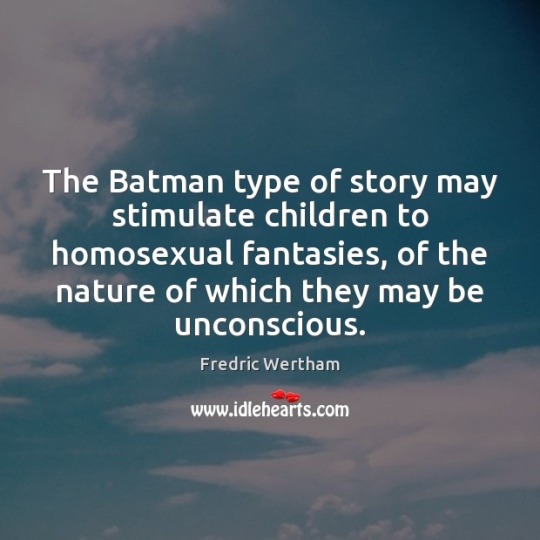
A book detailing and theorizing that violence and suggestiveness in comics and pulp fiction novels had a measurable, negative effect on the reader that inherently reflected the psyche of those who consumed them at length.
The book made Wertham famous, starting a moral panic across the country.
In Wertham's - and much of the countries eyes:

[also yes I had to verify that he did in fact say this as sourced by New Yorker Mag. Stan Lee should've kicked this antisemites ass]
In response - the Comics Code Authority was created - a code that dictated what could and couldn't be in comics, for the 'safety' of the reader.
This Code almost killed comics, almost putting Marvel out of business, until ten years later when Spider-man was created. Although it wasn't law - it was the panic of the public that enforced the Comics Code, completely sanitizing the industry for decades.
Gwen Stacy's death - a clear show of violence in panel - was one of the events to first 'break' this social code.
The issue it took place in - TASM #121 was released in 1973, almost twenty years after Wertham's moral panic.
It showed clear, unpeaceful death and tragedy, with NO resolution.
And fans ATE IT UP.
To this day, The Amazing Spider-man #121 is one of the most iconic issues in Spider-man's entire lore, with Gwen appearing in almost all of his movie franchises (Raimi, TASM, and ITSV), and her death characterizing MUCH of modern-day Spidey storytelling.
The reason I want to highlight this story is because I will always find it baffling, and SAD to see people saying that fanfiction or fandom art or favorite characters inherently reflect - or damage your psyche.
So often in fandom spaces - COMIC fandom spaces - I see this rhetoric parroted. That people who consume x are inherently more dangerous. That y shouldn't exist because it inherently damages those who consume - and enjoy it.
Unknowingly, but wholeheartedly claiming 'Seduction of the Innocent'.
That rhetoric comes from somewhere.
That idea - when it comes to video games, violent rap music, loud rock music, graphic TV shows, that such content warps the viewer simply by design - comes from one place.
Fredric Wertham, Seduction of the Innocent, and moral pubic panic.
Such an idea had a visible measurable effect on canon comics. So why does it persist in comic fandom?
They say those that do not know history are doomed to repeat it.
#just thinking out loud#spiderman#atsv#spider man#marvel#across the spiderverse#comics history#comics#itsv
51 notes
·
View notes
Text
@mzminola I saw your tags on this post:
#you all have so many names #is this because of DC eating Fawcett, or a tiff with Marvel Comics, or several reasons??? #everything I learn about the Shazam Fawcett City fam makes me more interested
And immediately got excited because I happen to know this story and I think it's fun. It's one of the more interesting nuances of comics industry skullduggery out there.
See, Captain Marvel was the most popular superhero of the 1940s, at least based on raw comic book sales; he even outsold Superman, and he was the first comic book superhero to get adapted into a film serial. And National Comics, the company that would eventually become DC, hated that, so they sued for copyright infringement on the grounds that the Cap was a blatant Superman rip-off, and they eventually won, forcing Fawcett to stop publishing Captain Marvel and his family in 1953.
Then in the 60s, when Marvel Comics came along, somebody there eventually noticed that the trademark to the name "Captain Marvel" was up for grabs, so they jumped on that with their Captain in 1967. Between Mar-Vell and his family, Monica Rambaeu, Noh-Varr and Carol Danvers, Marvel's never let that trademark slip out of their grasp in the decades since.
So when DC acquired the rights to use the original Captain Marvel and his crew, first through a license with Fawcett in 1972 and then essentially absorbing the smaller company entirety in 1992, they found themselves in the awkward legal position where they couldn't publish Cap's books under the name "Captain Marvel." They could call him that in the book, because they owned the rights to the character, but they couldn't use his name as the trademark for the series, or in any of their advertisements, and when they tried to edge around it by calling him, "Shazam! The Original Captain Marvel" they got a cease and desist.
Of course people who weren't familiar with any of this drama found it confusing that this was one of the only books in the line-up that wasn't named for its hero. So DC spent a long time through the 90s and early 00s going through different names for Captain Marvel (and to a lesser extent Mary and Junior) trying to find a name that would let people know that this was the same Very Popular Character as in the old days without tripping into Marvel's trademark lawyers.
---
Meanwhile!! Back in the 50s, over the the U.K., the small press that had been importing the Captain Marvel comics decided that, when their supply was suddenly cut off by the lawsuit, they'd recruit a local artist to just help them keep going by changing the name to a thinly veiled expy called Marvelman.
Marvelman was then revived in the 80s by Alan Moore as Miracleman, which was basically his first jaunt into the metatextual explorations of superhero comics that he'd become famous for. When he left that run it was taken over by Neil Gaiman, through whom a debate over the rights to Miracleman would eventually become central to a protracted lawsuit with Todd McFarlane over work Gaiman did on the Spawn comics.
You could probably write a pretty compelling history of the superhero comics industry just by following the trademark and copyright drama of Captain Marvel. I'm a little surprised somebody hasn't done it already tbh.
#comic books#comics history#captain marvel#shazam#fawcett comics#dc comics#I checked my dates against a few online articles but didn't go diving for deep references so apologies for the lack of citations
38 notes
·
View notes
Text
One of the worst things about the higher ups at DC from the mid-2000s to late 2010s being so obsessed with the Silver Age of comics is that if you go back and read that era it’s EXTREMELY clear that obsession purely comes from nostalgia.
The Silver Age is cool at Marvel because it’s the Jack Kirby power hour over there, but holy shit was it lame at DC. Every Batman & Justice League adventure from that time is almost hilariously nonsensical and is just… SO weightless and empty. And would you believe that Wonder Woman comics got MORE sexist over time?
That’s what happens when you’re policed by the Comics Code Authority, a council of Karens in charge of keeping superhero stories from saying anything meaningful.
31 notes
·
View notes
Text
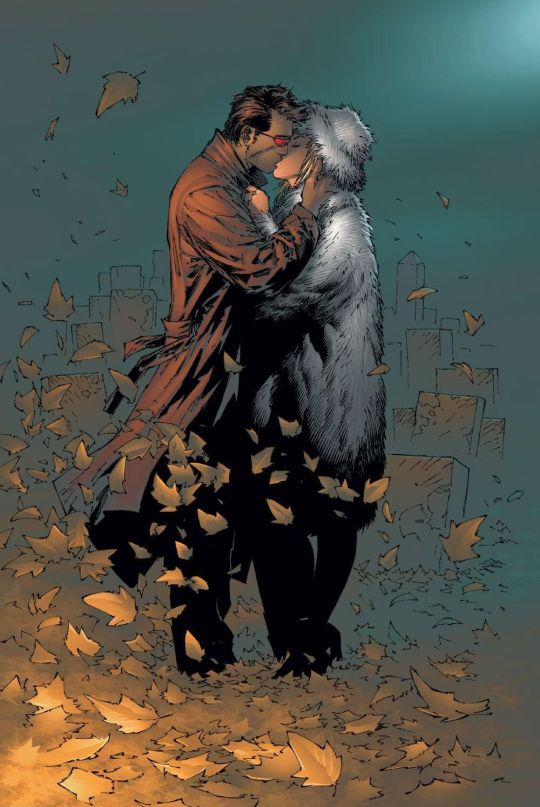

Scott Summers & Emma Frost sharing their first real kiss (and thus becoming an official item from this point on) by Marc Silvestri & co.
2004's New X-Men #154 (the 42th/last issue Grant Morrison's run) turn 20 years old today by the way (release date : March 17 2004). Feel old yet ?
#new x men#grant morrison#marc silvestri#2004#then the reload era#end of an era#cyclops#white queen#scott summers#emma frost#this is the end#at 20#x men#comics history#here comes tomorrow#future#past#present#top cow#marvel#kiss#romance#grave#funeral#happy ending#sorta#mutants#Morrison x men#2000s#to me my x men
22 notes
·
View notes
Text
Many of today’s most beloved superheroes were created by Jews, many of whom were children of European immigrants, during the height of Nazism in the 1930s-40s. They had relatives in Europe, they heard what was happening to their fellow Jews, and they used fiction to fight back.
During the Holocaust, Jewish men created Superman to be a champion of the oppressed and a hope for a better tomorrow. Captain America was created to be explicitly anti-Hitler and to encourage the USA’s entry into WWII. They are now some of the world’s most recognizable characters, and they’re the living legacy of Jewish creators who used art and storytelling to fight Nazism.
So, modern-day writers turning those characters into Nazis and totalitarian dictators is deeply disrespectful to the legacy of the Jewish creators who shaped the superhero comics industry.
#yes this is specifically about cap being hydra and superman being a villain in stuff like injustice#dc#marvel#dcu#dc comics#superman#clark kent#captain america#steve rogers#golden age comics#joe shuster#jerry siegel#jack kirby#wwii#tw antisemitism#injustice gods among us#comics history
97 notes
·
View notes
Text
An interesting thing I found out recently: Garfield might actually be public domain, attempts to fake him not being so aside, but only very specifically the extremely early version of him that appeared in Jim Davis' first "Jon" strips.
Though it might take some...

...extensive redesign work to make that specific version look at all appealing.
29 notes
·
View notes
Text

I got this ask on main but thought I'd pick it up here, my comics history/fashion ramble blog. I'd been wondering this exact same thing recently, and Google initially wasn't much help—Rocketeer replica jackets describe themselves only as "Rocketeer jackets" and the one Lobster Johnson cosplay thread just suggested ordering one of those.

The most curious part is the double seam and horizonal row of buttons that mark out the entire front as possibly being an unbuttonable "bib", like a plastron front. (Please don't ask how late in the game I worked out that "plastron" is the right word for that.)
The closest genuine Golden Age example of a plastron jacket I found was the military tunic style uniform of Blackhawk, created in 1941.

(Pics from the '52 movie serial (right) really show how awkward it is to combine open lapels + plastron. On a double breasted coat, that chest panel IS the bottom lapel, folded shut.)
Here's the thing: This outfit mirrors that of the Nazi ace pilot he fights in the origin issue, von Tepp (middle). And compare further to the far right: real life WWI flying ace Manfred von Richthofen, AKA the Red Baron, in imperial German Uhlan (lance cavalry) uniform.

"The Germans had designed such great costumes, we decided to use them ourselves," co-creator Cuidera is quoted as saying in Steranko's History of Comics, which (more dubiously, in my opinion) compares the look to the Gestapo or SS. Breeches or jodhpurs weren't strictly a Nazi thing at the time, but they do add to the overall effect.
Compare two other military tunic themed costumes from 1940, on Captain Marvel and Bucky Barnes. These are asymmetrically buttoned, and switch to a more classic circus strongman look below the waist.

But somewhere around 1975, with the Invaders book, Bucky gets a buttoned bib! There's something infectious about it—the symmetry, maybe. (Even re: the characters we started with; Mignola didn't draw Lobster Johnson with buttons down the right side, but every artist after does. And Spider-Noir wore a sweater under his coat until Shattered Dimensions introduced the double-breasted vest.)
If it didn't reach his belt, Barnes' button-on front + shirt collar combo would resemble a bib-front western shirt, like the one that became the Rawhide Kid's signature look in '56. (Or Texas Twister's in '76.)
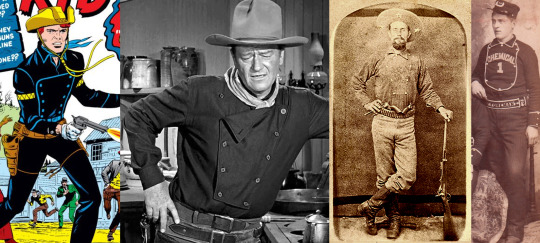
This shirt entered the old-West-obsessed public imagination in the 1940s/50s largely because John Wayne wore it in several cowboy movies. In reality it was rare among cowboys, more common with firefighters and civil war era militia.
Military tunics, Western shirts, alright, but does anything match the style and material and era, or are these jackets a total anachronism? I tried looking into 1930s leather flight jackets and was surprised when the closest-looking results were marked as Luftwaffe.
It took me a bit to work out why: USAF and RAF issued standard flight jackets with a center closure. The Luftwaffe instead let their pilots buy non-standardized ones. The 'weird' double-breasted black German flight jackets were in fact fairly normal (but repurposed) motorcycle racing jackets.
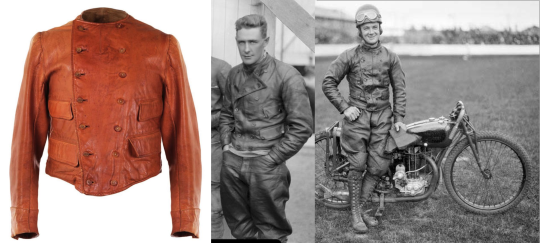
Far left is an English biker's jacket that dates back to the 1920s. Even without the bib, this may be as close as you'll get to an authentic Rocketeer. The jodhpurs were pretty common to complete the look. (What was an early motorcycle anyways, if not a weird metal horse?) The first biker jacket with the now iconic off-center diagonal zip was designed in America in 1928 and yet as far as I can tell, not a single actual pre-war pulp hero wore one.
The greatest weakness of this post is that I haven't been able to find any of these artists' notes on how, exactly, they arrived at similar versions of this iconic Pulp Front Panel Jacket. I'm sure I've missed some things. But as far as I can tell, this jacket is an odd bit of convergent stylistic evolution from the above influences that's picked up enough momentum to now be self-perpetuating.
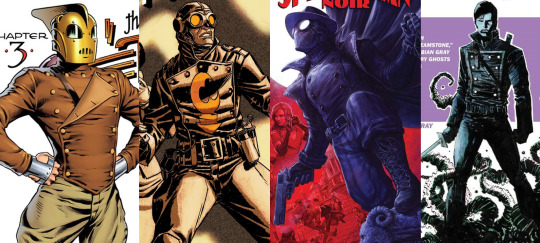
The problem with pulp heroes is that for the most part, they just wore clothes. The appeal of this jacket is actually very similar to what the 1940s thought the appeal of the bib-front shirt in westerns was: It's alien enough to feel "old". It looks like something invented before zippers or synthetic fabrics. It looks formal and militant but also renegade, rebellious. It also looks a little mad-sciencey*. It's a costume, but you can nearly fool yourself into thinking the past was weird enough that you could find something this cool on the rack.
If I wanted to end on some grand point, I could try to argue that there's a thematic throughline between fascist fashion, John Wayne movies, and throwback pulp. A manufactured aesthetic valorizing the violence of a fictional golden age... but I think the noir stylings of the post-Rocketeer comics in this lineup mean that, at least on some level, they know the "good guys" didn't dress like this.
*If I had another couple weeks of time to burn, I'd try to trace the visual history of the Howie coat in popular culture and investigate its possible connections to this. Alas, I do actually have a life.
#thank you for reading. also don't read golden age blackhawks the racism is awful even by era standards.#comics history#costume taxonomy#<- forgot I had that tag.#not to be like ''in MY favorite comics...'' again but may I point out that Hellboy and Robo and Tom Strong just wear... clothes#like. yknow. A pulp series that had confidence in itself rather than trying to cosplay as eras it thinks were cooler might do-#[I am yanked offstage before I can restart that rant]#the rocketeer
119 notes
·
View notes
Text
War of the Generations: Kyle Rayner vs Hal Jordan Fandom (1994-2004)
Trenchcoat Edgelords vs. Gray Pony Tail Comic Store Guys
There have been numerous vicious fandom wars, but this is the only one I can think of that, with my own eyes, I saw lead to actual fistfights that drew blood. This is one of the few times I describe a fandom battle and it is not a metaphor. You’re probably unfamiliar with this fight if you never hung out at Android’s Dungeon-esque comic book shops, or do not have at least one weird unmarried uncle.
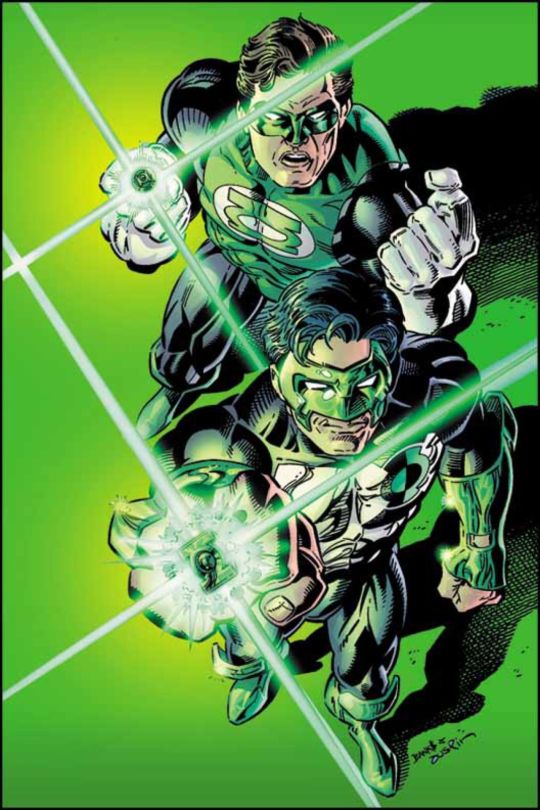
New characters, even replacement characters for established heroes, show up all the time. So it can be extremely hard to explain why this one in particular led to literally a decade of the most ferocious fighting. Why did this battle between fans of a replacement hero and fans of his predecessor become as immense and nasty as it got, when other characters didn’t? Why did young Kyle Rayner, GL replacement, get controversy when Wally West, Ben Reilly/Scarlet Spider, Thunderstrike, War Machine, and US Agent never did to the same scale?
Well, many reasons, but the main reason is that it wasn’t just a battle over one guy, but over a whole idea of what two wildly different kids of fans wanted comics to be, a vision of what superheroes would be going forward. That’s why this otherwise picayune fight had incredibly high dramatic stakes. Where was the heart of comics? Was it in breaking with the past that often locked comics up and fossilized them, moving in dynamic new directions, streetwise, and relatable, or was it found in moving with tradition, with classic ideas of heroes and science fiction? Was it found in relatability, or big idea scifi? In other words, this was not just a battle of a replacement character vs. the original, but over what comics would look like in the future, which is incredibly high stakes, by two groups equally invested in the outcome.
Rather, the crux of the conflict between Hal and Kyle fans was a generational divide. This was, quite literally, a war of the generations. You only need to see the characters to understand that. Hal Jordan was one of the old guys; he was one of a few heroes from the 50s who was allowed to age gracefully, since he got gray hair at the temples in the 1980s. Kyle on the other hand, was a Peter Parker-esque quirky, handsome and relatable young early 20something, an artist in New York.
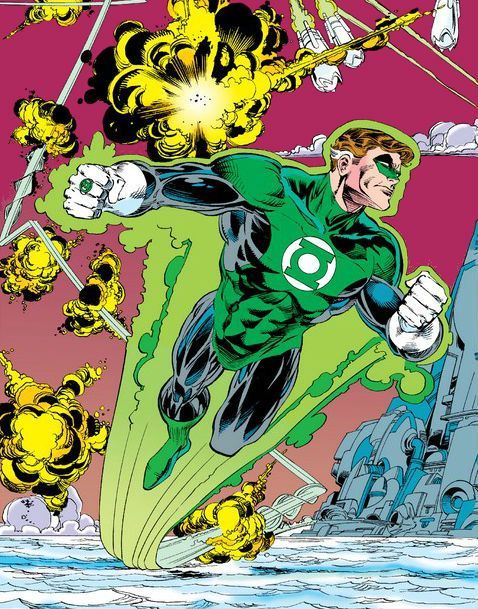
To be clear, this was a huge, organized fight, not just people snapping at each other in the early internet and in comic book stores (although there was plenty of that). Hal Jordan, the original GL, had die hards so intense that they were in something called HEAT – Hal’s Emerald Action Team. And it was not a little fanzine group, either. It was more akin to a non-profit like the World Wildlife Fund, in that it had dues paying memberships (I was one). HEAT actually sponsored a scholarship for talented young art students called the Gil Kane Memorial Scholarship. They literally put out an ad in Wizard magazine for their group. Imagine a fandom group creating a college scholarship from their dues.

It’s often very hard to discuss motive in conflict like this because we are entering the realm of the glandular, non-rational reaction. Ironic, because these two groups consider themselves rational men, but because they tend to have low emotional intelligence, are unaware that rationalism is caused not by ignoring your feelings, but by understanding them and holding them in balance. Okay, I honestly believe this: if they had replaced Hal Jordan and the other Green Lanterns with a girl, or with a tough black guy ex-army vet, it would have gotten far less hate from the particular group of people who ended up forming HEAT than a hot young guy who lives in New York and is a cool artist with an arty loft apartment like the characters in the musical Rent or the kids on Friends, and gets laid a lot with hippie chicks. Hot young guys are threatening to you if you’re getting older, and cool things are threatening to you if you’re uncool. And I honestly believe that is why, for example, books like the hip-hop infused Milestone Comics and anything by Christopher Priest absolutely tanked in the 90s: the guys who made up the comics store audience were turned off, even if books like the Crew and Static Shock vibed with the culture as a whole.

Add to all of the above the general glandular-level hate born in envy that men have for a certain kind of attractive young effeminate guy like Justin Bieber or Robert Pattinson. People hated Kyle Rayner for the same non-rational, glandular reason guys hated Justin Bieber in the 2010s. Likewise, on the Kyle side, there was a lot of rationalization for why Hal was boring and lame, but in the end, it ultimately came down to a visceral, glandular reaction to a guy that reminds you of authority figures, like your asshole assistant principal who spent high school terrifying you, or your cold, evil dad. And I can certainly understand why, if some cat-piss smelling comic book gray pony tail who is a dead ringer for Gary Gygax corners you and tells you anything, you believe the opposite. Never underestimate the persuasive power of coming off as “normal.”
It’s important to mention that part of the reason this generation gap was so pronounced was that DC had a lost generation of fans. If you started reading comics in the 70s and 80s, DC Comics were marginal. We have a vague idea that DC and Marvel were rivals, neck and neck like Coke and Pepsi, with dueling superguys, but at least in the 70s and 80s, it wasn’t even close to a competition, Marvel was winning hands down. Once Marvel got their own distributor in the 70s, DC Comics were a nonentity, barely making up a single digit percentage of the marketplace to Marvel’s overwhelming chunk. The implication of this is that, if you’re a long time DC fan, you probably started reading in the 50s-60s, since there really wasn’t an audience of DC fans who came in the next few decades. When DC started to revise their image and creative teams, getting rid of the old man workhorse artists (Curt Swan, Jim Aparo, Dick Dillin) and putting out Marvel style books like New Teen Titans, there was a huge influx of people into DC in the 90s, especially with the rise of the comics shop in the 90s as the main place comics are bought. To say there would be conflict between the new guard and the old is an understatement, and this was the flashpoint this conflict happened.

I mean, when Kyle Rayner fans called Hal fans “Hal’s Brigade of Loyal Virgins,” well, I hate to stereotype, but it stung because it is absolutely, completely 100% correct as a description of these people, almost always. If you really got invested in this on the side of Hal Jordan, you were obsessing over 2 decade old comics going back to the 50s, and the people who do this tend to be….how do I put this? Not normal. Especially at a time when comics were really marginal as a cultural force. Now they are at the white hot epicenter of culture, but no grown adult would admit to reading them then. Prior to 2001-2003 (Lord of the Rings feels like a cultural tipping point), if a woman entered the average comic book shop, they would draw gasps and all eyes would probably follow them. Because it seldom happened.
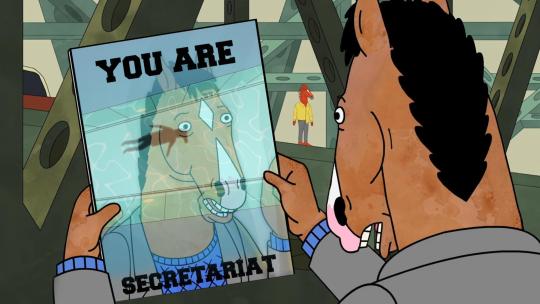
There’s also another element at work that you only see among old DC fans that went into this as well that is underdiscussed. They are often allergic to heroes experiencing temptation, vulnerability, or making mistakes, so obviously they’re drawn to the all-wise noble 50s father figures who are never wrong and resolve everything with some weird science trick (“don’t thank me, thank the gravitational pull of the moon!”), and who tend to always win cleanly. This type of person often enjoys projecting themselves into people like that, to deny any temptations or unpleasant character traits in ourselves. I hate playing armchair psychologist, but this cries out for it. It’s like when Bojack Horseman steadfastly refused to admit that his childhood hero, Secretariat, was anything other than a noble sports hero, when he was involved in illegal betting and was corrupted by fame. So obviously replacing Hal Jordan with a mortal Peter Parker type who was extremely fallible did not give them what they wanted and expected out of this book.
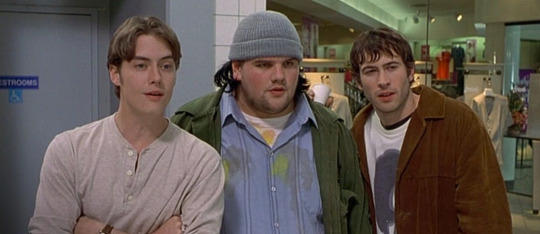
Alright, that’s the Hal Jordan fans, who are the Kyle Rayner fans? Well, like I said, in the 90s, comic book stores were at their peak. The Kyle fans were the young guys where the weekly comic store run was the center of their social world, the Kevin Smith types who tell bawdy Kryptonite Condom jokes. They wanted a relatable hero, and they put more of a priority on characterization and inner struggles over scifi explosions and time travel plots. They were also edgelords (to use a modern term) and loved rebellion. They also loved Japanese sword collecting. They tended to be fascinated by two things that came out at the exact same time: the tabletop game Vampire the Masquerade, and Mortal Kombat. In fact, no less of an authority as Rob Liefeld says that the reason comic stores went away in the 90s isn’t because of a speculator crash from people buying comics as an investment (which I always found utterly unconvincing as an explanation since I barely saw any speculators…how many could there be?) but because this particular audience, the Kyle Rayner guys, who went to comic book stores instead started to play video games instead.
They had very good reasons to want to be edgy and rebel. Since the cold war was won and neoliberal capitalism victorious, the system seemed all powerful and monolithic and invulnerable. As Margaret Thatcher said, “there is no alternative.” No wonder the culture was dominated by both rebellion and conspiracy theories about people in power (e.g. X- Files).
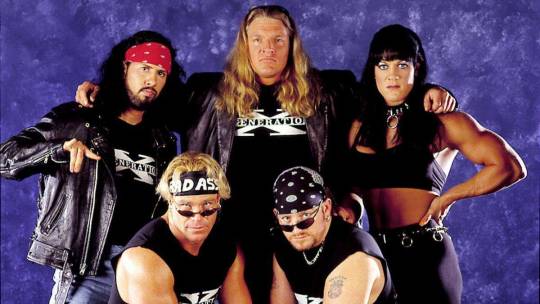
What’s more, in the 90s there was a strong desire to break from the past. It was all seen as slightly embarrassing. If you were a Star Trek fan in the 90s, you may remember that the original series was absolutely fringe and impossible to come across. Next Gen made a point to reference it as little as possible. There were barely any original series toys or merch as compared to today, as people were just embarrassed of the old show. TOS was like a crazy old uncle at the family reunion nobody talked to. And it wasn’t just Star Trek, either. Take the 80s icon, Hulk Hogan, who people absolutely hated in the mid-90s and booed, which is why turning evil was the best decision he ever made. When Doctor Who was canceled in 1989, nobody cared too much because it was seen as cringey and embarrassing and cheap, and the reaction was more surprise it was still on than shock it was canceled.

There’s something else, too. Nowadays, we have a much slower rate of cultural change: something from 2002 is probably more similar to something made today than something from 1982 is to something from 1962. In 1994, a comic from 1964, where Hal was created, must have felt like it came from the Old West or Victorian England.
This weird theme of generational conflict, because comics had a strange dual audience of old Gygax-esque gray pony tail guys and trenchcoat wearing edgelords who love Lobo and Mortal Kombat, absolutely defined the 1990s in comics, which is why comics from that era sometimes don’t make sense when read by normal people. Most of the time, the comics took the side of the gray pony tails because the guys creating this were gray pony tails, the ultimate example of the winners writing the history books. Mark Waid and Alex Ross made a generational battle the theme of Kingdom Come (one of the numerous reasons this comic didn’t age well) and he made an explicit point to not use Kyle Rayner as Green Lantern in a way that was so assholic that I actually kind of weirdly admire it.

There was one guy who used Kyle Rayner a lot: surprisingly, Grant Morrison. He saw Kyle’s Peter Parker like vulnerability and uncertainty as a strength to the character. The fact he was new, and a bit defiant of having to bow to tradition and held back, made us sympathize with him (yet another metacommentary). Kyle was overawed by the League, and in his words, “it was like playing with the Beatles.” To this day, there are a lot of people who turned around on the character because of his role in Morrison’s run on JLA.
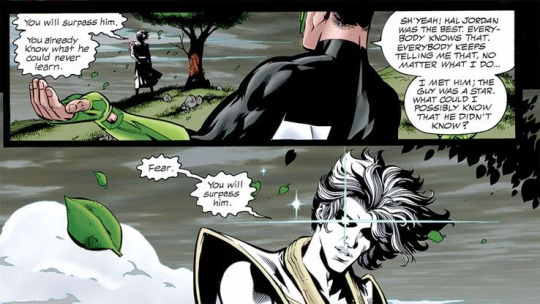
This is probably not exactly going to surprise anyone reading this who have followed my blog for a while, but I was on the side of the traditionalists then, and I was a Hal guy. I felt that the best thing that comics had going for them was their history, and to make a break with that, so cleanly, was a pointless waste. Remember: they didn’t just get rid of Hal Jordan, they had to do it in the most alienating way possible, turned a childhood hero heel, and they eliminated the scifi weirdness of all the funny space monsters. Yes, the GL Corps was clearly a product of the 50s and 60s, staffed with bugeyed monsters and Flash Gordon looking planets, but it had big cool scifi ideas in outer space that were at times legitimately breathtaking, ones that the more Spider-Man like Ron Marz GL stories didn’t have. Nevertheless….
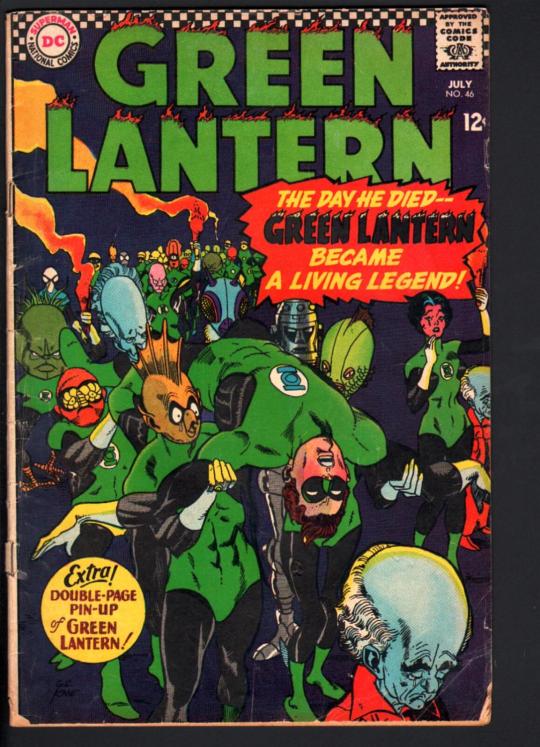
As strange as it sounds, looking back and revisiting all this almost two decades later, I find myself having a lot of unexpected sympathy for the Kyle fans and their position. If you’re young, old people are terrifying and the power of tradition is absolute. It feels like their ideas have a death grip on the world and they have the power to crush anything new you might come up with or ever aspire to be or do. I wonder if, in today’s world, where everything is a reboot of the same 10-15 eighties movies, younger people might feel this crushing weight of the past on them even more sharply than ever. “Why can’t we tell our own stories to describe the world around us the way previous generations did? Why is it that if I want to make a dramatic show about relationships, in order to get made, it has to be about friggin’ Archie and Jughead? Why can’t we have our own heroes the way generations before them had?” I mean, after all, even Hal was not the first Green Lantern, but a 50s update and rejiggering of a World War II character. Why does nostalgia have such a grip over us? Hal vs. Kyle was the beginning of that kind of fight and I have a feeling the biggest one is yet to come.
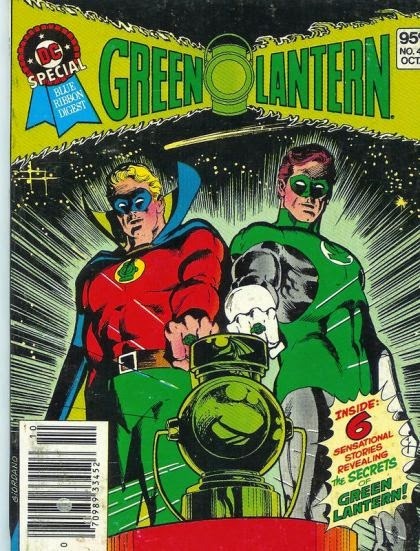
As a rite of passage, every generation gets to kill the previous one’s idols. Why? Because sometimes the old people are wrong. I remember reading Rolling Stone’s list of the greatest albums of all time, and at the top they put Sgt. Pepper’s Lonely Heart’s Club Band. It was controversial (personally, I don’t think it’s even the best Beatles album, really) but what added fuel to the fire was how Rolling Stone explained that decision: “you had to be there, man, the album changed the world.” In other words, it was up there because of Baby Boomer nostalgia and that generation’s total cultural dominance for a long period of time. I think guys who say the Beatles actually suck are unpleasant tedious edgelord shitheads, but I get it, I understand the desire to pit your living will against the dead hand of tradition.
The most extraordinary thing about the Kyle vs. Hal conflict is that it (mostly) ended. I never expected that. This is astonishing to me, I expected the ape inhabitants of a post atomic future earth to continue this fandom battle until the sun winks of existence.
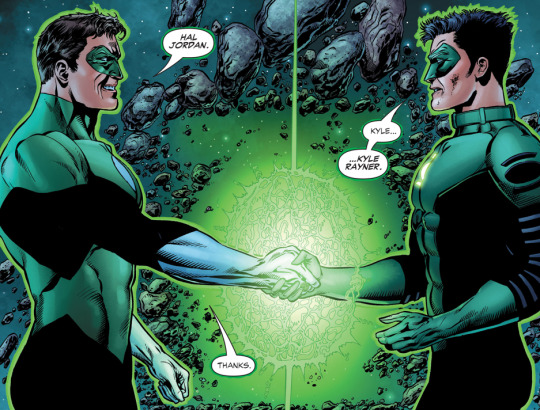
Why did this battle come to an end? Part of it was that a gigantic chunk of the Kyle Rayner audience simply vanished with the comics store collapse, as they switched to video games. In other words, HEAT just ended up winning by default. It’s not just that, though. The other thing that happened was that people acquired a different relationship to the past in the post-9/11, sentimental, non-ironic world as opposed to just kneejerk defiance. People started to rediscover old comics as valuable for their great creative power, and all the great works of the 2000s were like miniature primers on comics history, like Astro City and Alan Moore’s ABC. What changed in the 2000s is that people stopped calling them old comics, and started calling them classics. Around the 2000s, comics started getting a strange veneration about them, possibly because themes of good vs. evil and heroic purpose resonated after September 11th and the War on Terror, when the superhero movie came into style.
Most of all, it got resolved with Geoff Johns’s Green Lantern run. They brought Hal and all the other classic GLs back in a way that was, in many ways, as epochal and consequential as when Hal Jordan was introduced to replace Alan Scott. The GLs were recontextualized in an emotional spectrum with different colors. Nekron and the Weaponeers of Qward, the deep GL lore, as it were, which was mostly untouched since “Stainless” Steve Englehart left the book in the 80s, came to the fore. They simultaneously delivered modern-style action mixed with nerd nostalgia, at the best possible moment, the right book at the right time, when nerd nostalgia became a cultural force capable of moving mountains, right when superheroes became the white hot epicenter of pop culture. I don’t think it’s wrong to say that being on this book, the right one at the right time, paid for Geoff Johns’s house. Kyle Rayner of course, was right in the middle of this, his unique stature as the only GL for a while acknowledged, but let’s not kid ourselves, Kyle was pushed offscreen for Sodam Yat and Simon Baz.
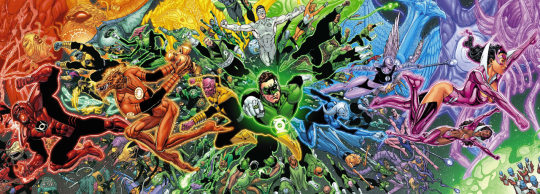
The Geoff Johns GL is now a part of the background, a product of a moment where nerd nostalgia was starting to be a powerful force. It’s not a coincidence that Geoff Johns took over writing GL the same year the first vinyl funko pops were made (around 2004). All that was in the ether. And I think we are now starting to see a reversal of things. There was once something very bold, self-confident, and defiant when Geoff Johns had veneration for classic old heroes, but now they’re everywhere and took over the world, the overculture, the same way the inescapable boy bands were in the 2000s.
I am not sure what comes next, but the pendulum is starting to swing on this. The classic characters created by cigar chomping WWII vets are now a kind of oppressive overculture and things are bound to change, because they can’t continue going the way they used to. I’m not sure what form the next great cultural/generational battle will take, but I expect there to be a lot of anti-superhero stories.
301 notes
·
View notes
Text
Tʜᴇ Kɪʟʟɪɴɢ Vᴏᴛᴇ
Thirty-five years ago, DC Comics opened a phone poll to kill Batman's child sidekick, Robin.
The poll was open to paying callers in the U.S. and Canada for a window of 35 hours, starting on 15 September 1988 at 9AM EST. There were two premium-rate phone numbers—one for Robin's survival, and one for Robin's death. Each paying caller could call multiple times. The results were decided by a margin of 72 votes out of a total 10,614 votes—the difference was just under 0.68%.
Now you decide.

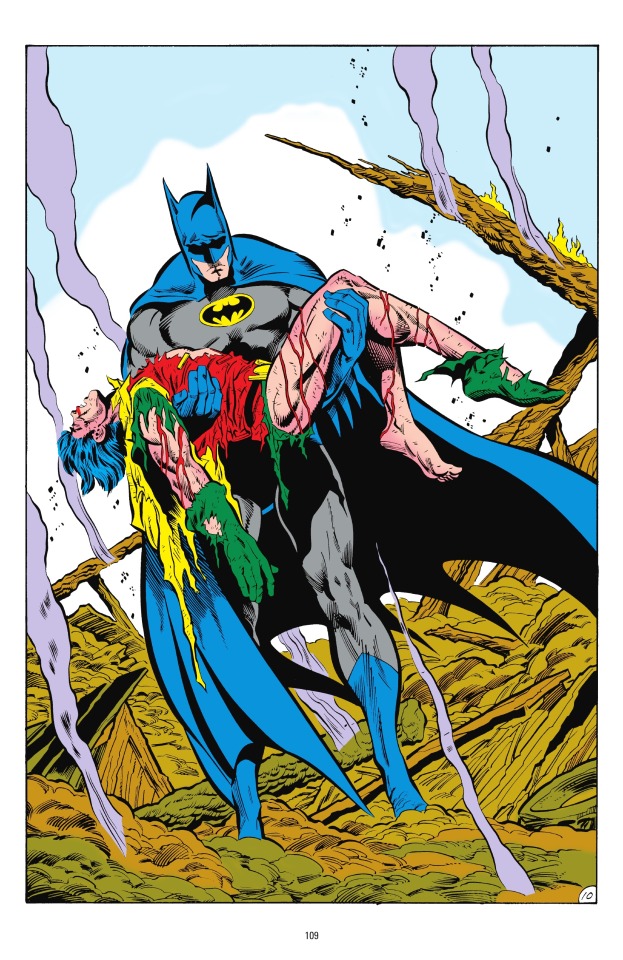

KILL ROBIN
Jerry Smith of Covington, Kentucky claims to have sold his Mercedes-Benz to pay for votes to kill Robin
"Who Killed Cock(y) Robin? I Killed Cock(y) Robin" article by Glen Weldon (2008)
"1-800-DEAD-ROBIN" autobiographical comic by Tony Wolf (2015)
"We killed Jason Todd" feature by Matt Markman (2021)
SAVE ROBIN
Senator Patrick Leahy (D-Vt.), a noted Bat-fan and scholar, denounced the episode as a "Roman gladiator-like readers vote."
"I loved him [...] I personally voted for him to live 100 times, and my mom flipped when she saw the phone bill," says magazine writer Savas Abadsidis.
MJG6 said: I was dead broke, working my way through college, but I voted. My first job was at a comic book store, making me an OG fan girl, I guess, and I encouraged people to vote to save him. [...] Because killing a teen, in a role kids are supposed to identify with, that was just sick.

Further Reading
"A Death in the Family, or: How DC Comics Let a Phone Vote Kill Robin" via r/HobbyDrama
"Living Dead Boy: Jason Todd vs. The Culture That Killed (and Resurrected) Him" on Women Write About Comics
"The Vote to Kill Robin" - trivia, misconceptions, opinions by comic-commentary
Some fan letter columns from Jason's later times as Robin
No Birds Allowed: Batman without Robin
"A lot like Robin if you close your eyes": Displacement of meaning in the Post-Modern Age by Mary Borsellino, an essay on dead Robins, sexism, and classism
🦞 The Tale of Larry the Lobster 🦞
Submitted arguments below:
Kill Robin
Anonymous propaganda IN FAVOR of killing the lobster the Robin!
I love Jason Todd. I love his post-crisis Robin days, I love his sense of justice and his adorable love of learning and his silly curly bangs! I say this to emphasize that I don't want him killed out of any dislike of the character.
I want him dead out of a love for storytelling that gets to stick to its guns and doesn't pull its punches. In context of the poll we readers have just seen Dick Grayson get kicked out of the role due to Bruce's fear of him getting hurt, then he turns around and gets a new Robin anyways because he misses him! I really like that Bruce is being messy and hypocritical! Let that have some real consequences please!
If there were no real consequences then Dick got shoved out of being Robin for what? Hairbrained overprotective worry? Why even change the way he graduated into being Nightwing so much then or heck why even kick him out in the first place?
One might argue that we haven't even given this Robin proper time to develop, that instead he might be taken in new and interesting directions as his own unique Robin shaping the mantle into a legacy rather than just something that was Dick's. I admit this is a very good point, and we are cutting off some possible interesting avenues. As I mentioned, I do like this character! But are we really going to get that?
If DC is already prepared to toss him out of this mortal coil and through the pearly gates after such a short while, do we really think we're going to get much more love and care applied to him?
I say let's roll the dice for something new! May the comics world and all these characters have to deal with the ramifications for many years to come!
Save Robin
robin’s death (and subsequent resurrection) is, frankly, an insult to robin fans of that era. to want to see this child get killed in a brutal manner for no apparent reason, to see jason essentially removed from the narrative so batman could go back to being gritty and depressed—this is awful to me. he hadn’t even been robin for very long!
but that’s not why he should’ve lived.
the resurrection of jason todd as the red hood was narratively interesting enough that it kept most fans of the original jason hooked, and it still does! he has become a prime example of a trauma survivor: his death changed him, and those who loved him have difficulty accepting that.
but there is no resolution to that story, nor was there a resolution to jason’s tenure as robin. dick chose to leave robin behind and take on a new mantle. tim, steph, both had robin taken away from them (and let’s forget about how tim is still robin, because that doesn’t matter right now). damian’s role as robin conflicts with his misconception of his role in the family. everyone else has had an ending, and jason’s death…well. after his resurrection, he has somehow remained stagnant and wildly inconsistent at the same time. this applies to under the red hood too.
at its core, utrh is a deeply classist retelling of jason’s life pre-death in the family. winick makes him a villain—albeit a sympathetic one—who fucks over or kills people that he would’ve thrown himself in front of to save as robin. in utrh, the implication is that jason had always been violent and angry (and morally compromised), and that he was destined to become worse.
it sometimes feels that jason’s transition into being the red hood (and all the characterization that comes with that) was a decision dc made for shock value. just from jason’s robin run, it’s difficult to imagine jason becoming the red hood. it doesn’t feel inevitable. it’s tragic.
ultimately, i believe that jason never should have died, and that his death was a stunt by dc for its shock value. jim starlin wanted jason dead because to him a child sidekick, in a medium that was originally made for children, was “sheer insanity”. he was fridged, plain and simple.
#DC Robin#DC Comics#Jason Todd#Robin DC#DC Joker#Joker DC#Batman comics#Batman#Batfamily#thekillingvote#comics#Batman A Death in the Family#Jason Todd meta#Batfam#Batkids#Batbros#comics history#ADitF#1988#described#ID in alt#image ID#ID in alt text
126 notes
·
View notes
Text

Jack Kirby also served in the European theater during WWII too.
67 notes
·
View notes
Text
I was reading Superman For All Seasons and in the first issue, Pa Kent is talking about Clark for pages and pages. And it’s really quite beautiful. Because what Pa Kent mentions is “the morning [he] found [Clark] standing up in his crib for the very first time, just busting with pride with a smile as big as the moon.” And “Watching him push back the screen door and toddle out on his own into the yard — talking to the dogs and the ants and the porch swing.”
Reading that, I really internalized the fact that Clark is Jonathan’s son. Almost every single Superman story -outside of maybe Smallville- never touches on Clark and his family. It’s always Krypton, it’s always Clark gaining powers, it’s almost never about Clark being Jonathan’s son. We always focus on Krypton, hell, Man of Steel started with a long-winded sequence there. Except in For All Seasons.
We always remember Krypton and Jor-El’s importance to the story, but not Pa Kent. We always remember the alien, but Jonathan, in For All Seasons, knows “There are things about being a father [he’d] remember for all [his] days.”
13 notes
·
View notes